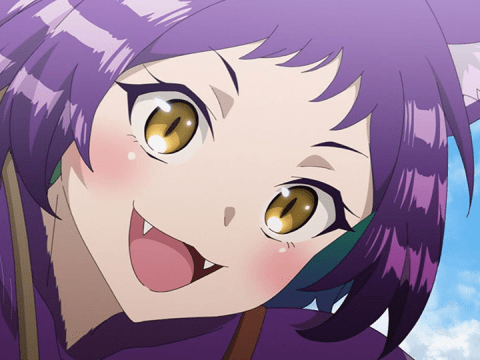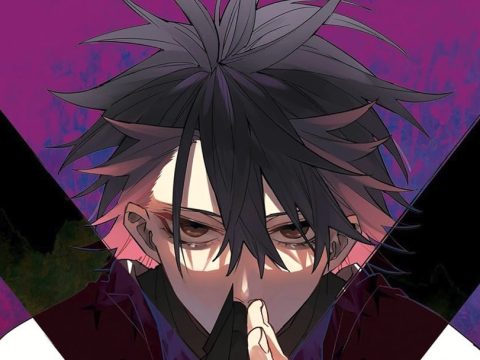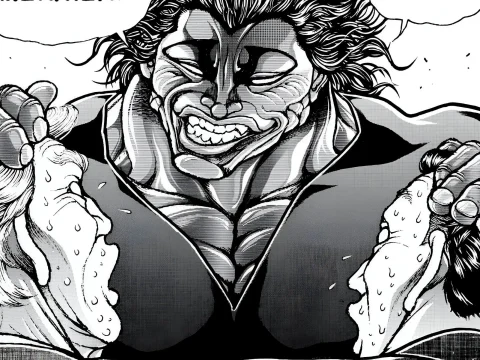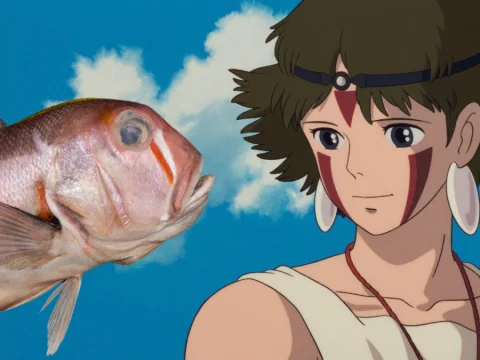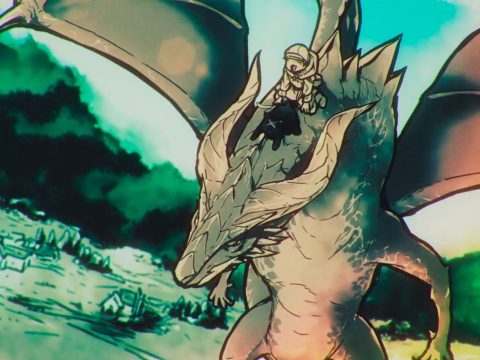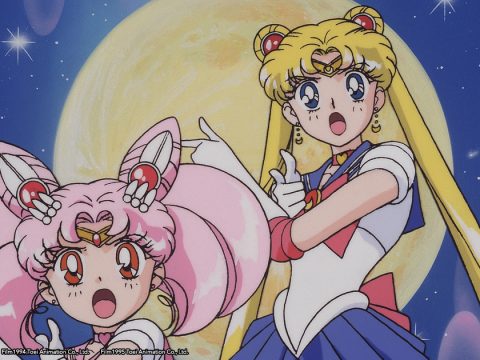A festival parade of marching appliances. Evil, laughing, building-sized dolls. Movies come to life, a 50-foot woman, a butterfly collection with a centerpiece human butterfly. If surrealist tea parties are your bag, baby, Paprika is a patchouli-scented, smoke-filled room, just waiting for you to drop in and pull up a chair …
Nightmare Parade
 Paprika can interface with her patients’ dreams, manifesting as a cute redhead in high-water chinos and a tight T-shirt, but also able to take on whatever role or appearance seems appropriate in the dream at the time. Superhero-like, Paprika can stop time, fly on a cloud in the costume of the Monkey King, become a winged sphinx, a mermaid, a wand-waving winged fairy, or grow into a towering giantess. She skips through the opening credits like a magical sprite, leaps ghostlike through TVs, computers, billboards, even a picture on a passerby’s T-shirt. It’s easy to see how such a character would be a release for the humorless Atsuko, whose daytime persona is more interested in decorum and following the rules.
Paprika can interface with her patients’ dreams, manifesting as a cute redhead in high-water chinos and a tight T-shirt, but also able to take on whatever role or appearance seems appropriate in the dream at the time. Superhero-like, Paprika can stop time, fly on a cloud in the costume of the Monkey King, become a winged sphinx, a mermaid, a wand-waving winged fairy, or grow into a towering giantess. She skips through the opening credits like a magical sprite, leaps ghostlike through TVs, computers, billboards, even a picture on a passerby’s T-shirt. It’s easy to see how such a character would be a release for the humorless Atsuko, whose daytime persona is more interested in decorum and following the rules.
As she leaves her client, Paprika morphs back into Atsuko and returns to her day job at the Foundation for Psychiatric Research, only to discover a crisis in progress. A DC Mini has been stolen, and this is not only an embarrassing situation for everyone involved, but it’s also a potentially dangerous one as well. The DC Mini also allows its user to record dreams, for later analysis in “psychotherapy machines.” If the idea of hackers cracking into your e-mail worries you, imagine having your dreams available for replay on a laptop.
 Worse yet, instead of creating the ultimate YouTube channel with the device, the thief uses the DC Mini to gain access to other people’s dreams through the psychotherapy machines and to blend them together, creating a rampaging nightmare that quickly absorbs anyone who’s used the machines. Victims of this psychic attack spout gibberish and march off to join an imaginary parade, a colorful procession of dolls, frogs, robots, and refrigerators that grows more sprawling and elaborate with each new infected dreamer. Eventually, the parade of streetlights and vending machines, furniture and umbrellas, torii temple gates and the Statue of Liberty, spills over into the real world. The streets of Tokyo are taken over by a juggernaut of chaos, transforming everyone it contacts into marchers in the parade. Paprika, the dream superhero, with a little help from Detective Konakawa, is the city’s only hope.
Worse yet, instead of creating the ultimate YouTube channel with the device, the thief uses the DC Mini to gain access to other people’s dreams through the psychotherapy machines and to blend them together, creating a rampaging nightmare that quickly absorbs anyone who’s used the machines. Victims of this psychic attack spout gibberish and march off to join an imaginary parade, a colorful procession of dolls, frogs, robots, and refrigerators that grows more sprawling and elaborate with each new infected dreamer. Eventually, the parade of streetlights and vending machines, furniture and umbrellas, torii temple gates and the Statue of Liberty, spills over into the real world. The streets of Tokyo are taken over by a juggernaut of chaos, transforming everyone it contacts into marchers in the parade. Paprika, the dream superhero, with a little help from Detective Konakawa, is the city’s only hope.
 Nightmare sufferer Detective Konakawa has been haunted by dreams that resemble scenes from movies. He sees himself as Tarzan, as the protagonist in a spy thriller, and a cop chasing a crook. Later, we discover that there is a reason for this that is rooted in his past, but the very idea of movies-as-dreams and dreams-as-movies is a central image in Paprika. In one scene, Paprika even watches Konakawa’s dream in a darkened movie theater, munching popcorn.
Nightmare sufferer Detective Konakawa has been haunted by dreams that resemble scenes from movies. He sees himself as Tarzan, as the protagonist in a spy thriller, and a cop chasing a crook. Later, we discover that there is a reason for this that is rooted in his past, but the very idea of movies-as-dreams and dreams-as-movies is a central image in Paprika. In one scene, Paprika even watches Konakawa’s dream in a darkened movie theater, munching popcorn.
In Paprika, any fiction or fantasy is a portal to dreams. Toys, dolls, amusement parks-Dreamland is the name of a theme park in the movie-paintings, suits of armor, anything that a person might by inspired by or fantasize about. The Internet, too, is a pipeline into the fantastic. “Don’t you think dreams and the Internet are similar? They are both areas where the repressed conscious mind vents,” Paprika points out.
And it’s the venting of those unconscious minds that ultimately turns out to be the point of Paprika. Both Atsuko and Konakawa have to learn to release their psychic pressure valves in order to do battle with nightmares in the world of dreams, and the ending of the movie is particularly interesting in contrast to Kon’s previous Paranoia Agent. Without spoiling too much, let’s just say that fantasy in Paprika can be a confusing parade, but that it also represents freedom. And who wouldn’t want to be free to roam around a world where anything can happen?
[Look for more Paprika coverage in the December 2007 issue of Otaku USA, on sale now!]


